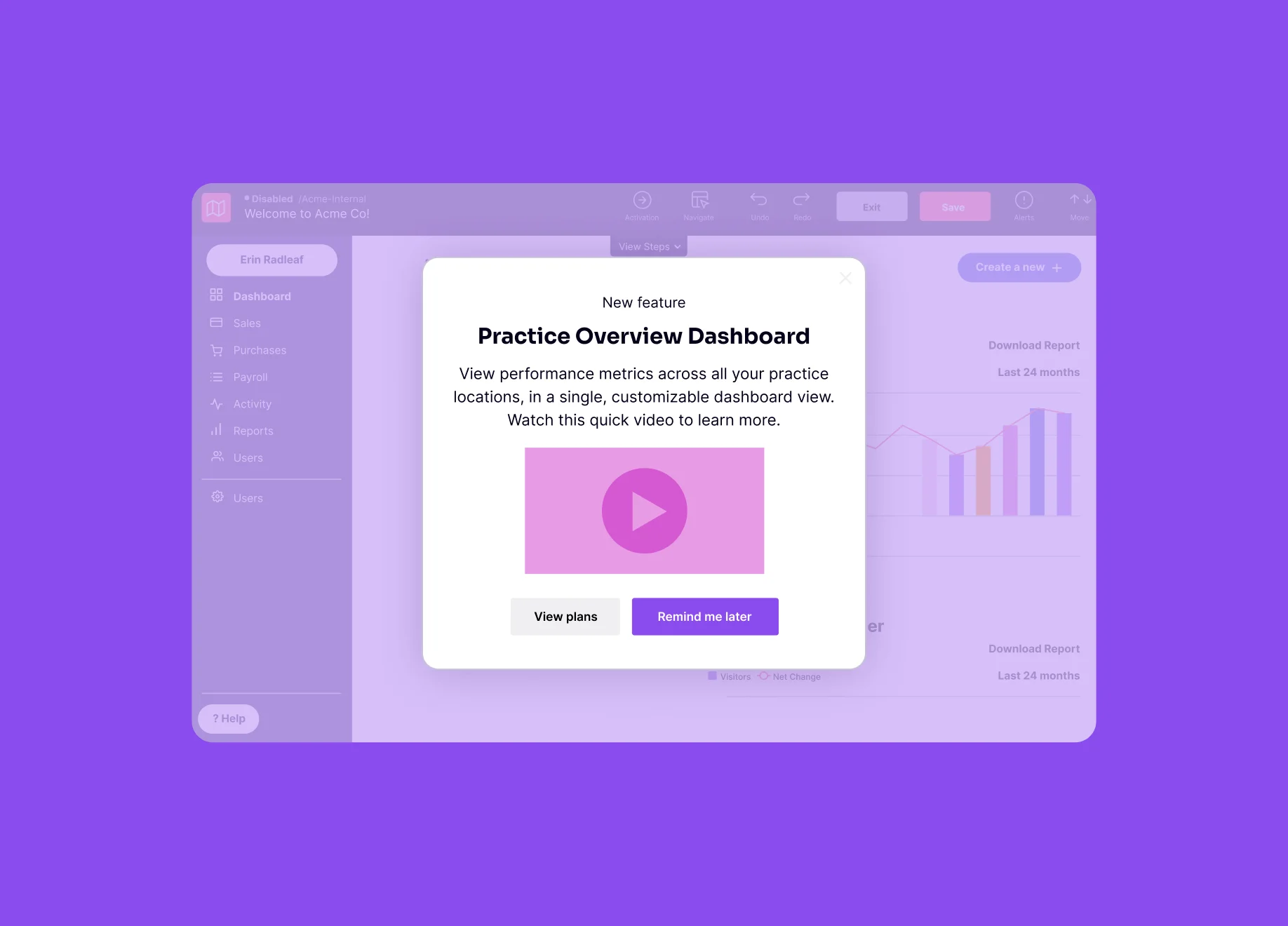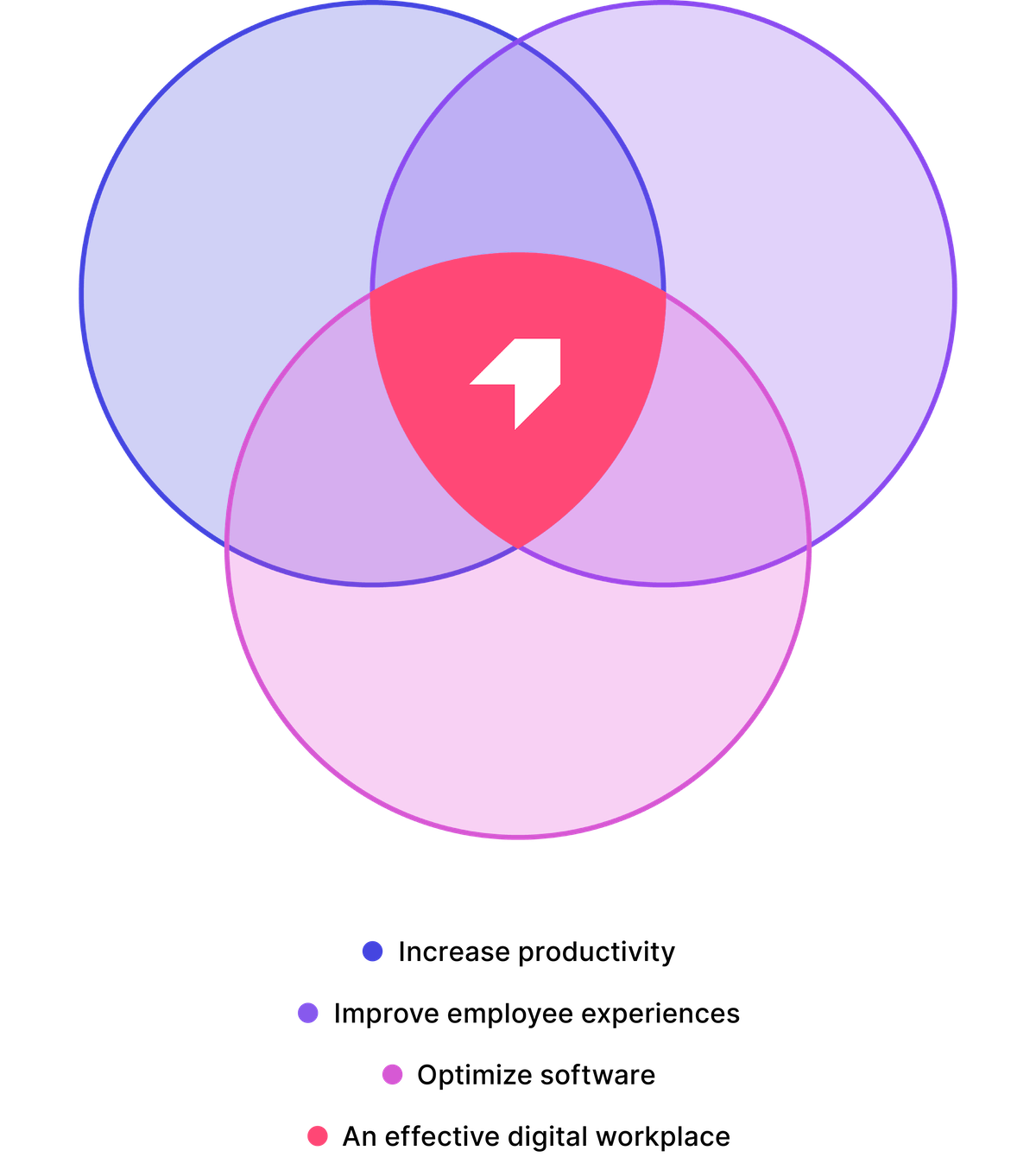
デジタルアダプション
ユーザーがデジタルツール(ソフトウェアプロダクト、アプリ、ウェブサイトなど)を最大限に活用できる状態。
さらに深く掘り下げる
目次
デジタルアダプションとは
Digital adoption is the process by which users learn to leverage new technology (software products, apps, websites, etc.) to its fullest potential and derive maximum value from a digital process or solution.
デジタルアダプションは人間中心のプロセスで、テクノロジーそのものだけでなく、テクノロジーを使用する人々にも重点を置いています。 生産性を高め、ユーザー体験を向上させ、ソフトウェアの最適化を図ることを目的としています。適切なデジタルアダプション戦略は、これら3つの柱の交点に位置し、効率的で成熟したデジタルワークプレイスを実現させます。
デジタルアダプションが重要なのはなぜですか?
In today’s rapidly evolving digital landscape, embracing new technologies and processes is no longer optional. It’s essential for business survival and growth. Consider the consequences to organizations without digital adoption.
- デジタルディスラプションはあらゆる業界で続いており、企業は、効率性の向上、顧客体験の強化、競争力の獲得を可能にするデジタルアダプション戦略を導入している競合他社に遅れをとるリスクがあります。
- デジタルの成熟度が低い企業は、デジタル先進企業と比較して生産性に大きな格差があり、収益や機会の損失につながっています。
- 新しいテクノロジーを効果的に活用するためのスキルやサポートがなければ、従業員は不満を感じてやる気を失い、離職率の上昇につながります。
- また、デジタルテクノロジーは常に進化しているため、デジタルアダプションの実施に苦戦している企業は、これらの進歩をイノベーション、プロダクト開発、顧客サービスの向上に活用する機会を逃しています。
According to a 2021 report from Harvard Business Review Analytic Services sponsored by Pendo, 89% of executives say that driving the adoption of employee-facing software is a priority, but only 30% say their organization is highly effective at doing it. The other 70% risk:
- Increased operational costs due to inefficient workflows and manual processes
- Loss of market share to competitors who actively leverage technology to boost sales
- Employee disengagement and attrition due to outdated tools and lack of training
- Reduced agility and innovation, without which they cannot adapt to a fast-changing landscape.
これらのリスクを軽減し、持続可能な成長と成功への道を切り開くためには、企業は調達したデジタルツールを、従業員ユーザーにも顧客ユーザーにも確実に定着させなくてはなりません。
主なカテゴリー
ほとんどのデジタルアダプションの取り組みは、次の2つのカテゴリーに分類されます。
顧客向けのデジタルアダプション
顧客向けのデジタルアダプションは、顧客向けのプロダクトやアプリケーションへのユーザーエンゲージメントの促進に重点を置いています。そして、ユーザー満足度やプロダクト使用率、最終的には顧客リテンションを向上させることを目標にしています。たとえば、新しいモバイルアプリやソフトウェア機能をリリースする場合、顧客向け戦略により、ユーザーはアプリを簡単に操作したり、最新の機能を見つけて使用する方法を理解したりして、それらを活用できるようになります。
従業員向けのデジタルアダプション
Employee-facing digital adoption focuses on ensuring employees understand and effectively use internal software and tools to improve workflows, boost productivity, and achieve business goals faster and with less friction. For example, when deploying a new ERP system, an employee-facing strategy should make onboarding employees to the new platform as painless as possible.
デジタルアダプションにはどのようなメリットがありますか?
デジタルアダプションの最も明白なメリットの1つは、企業が構築または購入したテクノロジーのROIが向上することです。しかし、デジタルツールの定着化が成功すれば、さらにビジネス全体にプラスの影響をもたらします。
Digital adoption is also about empowering your workforce to leverage these tools effectively, transforming how your business operates and interacts with customers. When users (whether customers, employees, or both) maximize the value of their technology, they are happier, more productive, and more likely to remain users. Here are some of the most common benefits of:
- Improved workflows and internal efficiency — Imagine using a new project management tool to streamline team communication and collaboration, allowing for real-time updates, task delegation, and centralized file storage. This tool can eliminate lengthy email chains, scattered documents, misunderstandings, and errors, leading to faster completion of projects.
- Increased productivity — Adopting digital tools can automate repetitive tasks, freeing valuable employee time for more strategic work. For example, automated marketing campaigns or data entry tools can significantly reduce the time spent on mundane activities, allowing employees to focus on tasks that require creativity and critical thinking.
- Less user frustration with technology — Struggling users can quickly become overwhelmed and abandon new systems, hindering adoption and ROI. Digital adoption strategies like clear guides and in-app support minimize frustration and encourage continued engagement.
- Higher customer and employee satisfaction — Customers who can easily use a product or service are more likely to be satisfied and loyal. And empowered employees who can use a technology effectively experience greater job satisfaction and contribute more to the company.
- Reduced costs — Extensive training, errors, and rework can significantly increase operational costs. Digital adoption helps companies maximize their technology investments by minimizing training needs, streamlining processes, and reducing errors.
- Data-driven decision-making — Digital tools generate vast amounts of data on customer behavior, operational performance, and market trends. By leveraging analytics platforms, businesses can gain valuable insights to inform strategic decision-making and identify areas for improvement.
デジタルアダプションとデジタルトランスフォーメーションの違いは?
「デジタルアダプション」と「デジタルトランスフォーメーション(DX)」は同じ意味で使用されることが多いですが、両者の間には決定的な違いがあります。
- Digital adoption refers to successfully integrating and utilizing new digital technologies within an organization. It ensures users (customers or employees) embrace and effectively use the latest tools and processes.
- Digital transformation is a much broader concept that encompasses the complete overhaul of an organization’s operations, culture, and business model to leverage the power of software and other digital technologies. It involves not just adopting new tools but also reimagining and optimizing how work gets done.
簡単に言うと、デジタルアダプションはデジタルトランスフォーメーションを構成する非常に重要なパーツであり、ソフトウェアを使用して進化する需要に適応するプロセスです。たとえば、ソフトウェアソリューションが手動プロセスに取って代わる場合、従業員がかつて手動で行っていたことを新たにデジタル化した状態に移行できて初めて、完全なデジタルアダプションが実現します。
デジタルトランスフォーメーション(DX)において、デジタルアダプションはどのような役割を担っているでしょうか?
In a company where employees successfully adopt workplace software, digital transformation efforts are much likelier to succeed. Successful digital transformation, among other elements, means employees become confident and empowered to use the digital tools to help them thrive in the workplace. It’s also a process in which employees become a part of the change itself, providing business technology and ops managers with critical feedback and demonstrating new and better ways of working that can inform how they plan digital change for the better going forward.
例
What successful digital adoption looks like can vary widely depending on the nature of a company and its goals. However, it always involves employees or customers or both embracing the digital tools they are provided, and it ends with elevated user experiences and stronger business outcomes.
For example, JLL, one of the foremost commercial real estate companies, successfully drove awareness and adoption of new features on internal-facing market research and data-visualization apps using in-app notifications and robust analytics. In doing so, they closely tracked user satisfaction with these apps and were able to improve ratings over time. Essity, a leading global health and hygiene company, was able to drive digital adoption by automating onboarding for its users and using in-app guidance to walk its sales employees through essential processes.
これらの例やその他の数え切れないほどの成功事例は、デジタルアダプションが新しいテクノロジーの導入にとどまらないことを浮き彫りにしています。 適切なツールとトレーニングをユーザーに提供することで、ユーザーは企業のデジタルトランスフォーメーションジャーニーに積極的に参加するようになります。 これにより、イノベーションが促進され、従業員の能力が開花し、顧客ロイヤルティが構築され、最終的に組織の競争力が高まり成功につながります。
デジタル導入を増やすにはどうすればいいのか?
プロダクトを可能な限り直感的に操作できるようにすることに加え、企業のユーザーベース全体でデジタルアダプションを促進するのに役立つ、具体的な戦略をご紹介します。
- Onboarding: By creating an effective onboarding strategy, companies can ensure users — employees or customers — become proficient in an application as quickly as possible and recognize its value, driving retention and preventing churn. For example, you can provide:Tailored experiences: Create different onboarding experiences for new users based on their roles and needs.
- Interactive tutorials: Go beyond static text instructions and provide interactive tutorials, walkthroughs, or short videos to guide users through key features.
- Clear value proposition: Communicate the value proposition of the software app and how it benefits users in their daily tasks.
- Measurable outcomes: Track key metrics during onboarding, such as time to complete tasks, to identify areas for improvement.
- In-app guidance: Beyond onboarding, users need contextual information while using the product. Many companies use in-app messaging to communicate at the right moments and guide users to success. Cartegraph uses in-app messages to drive behaviors in their app that lead crews to complete fieldwork more efficiently. Six months after launching these guides in their mobile app, the team saw a 62% increase in mobile adoption. Other helpful features might include:Contextual walkthroughs: Trigger short, interactive walkthroughs based on user actions or specific features the user is accessing.
- Tooltips and cheat sheets: Offer quick, contextual tooltips and cheat sheets that provide easy-to-access reminders and guidance within the application.
- Search functionality: Implement a robust search function within the app to allow users to find answers to their questions quickly and efficiently.
- Ongoing education: Since digital adoption is a continuous process, it’s vital to keep users engaged and informed with ongoing educational resources after onboarding is complete, especially when there are any product releases, changes, or updates. Some tactics include:Regular webinars and training sessions: Host regular webinars or training sessions to highlight new features, address common questions, and showcase best practices.
- Knowledge base and user guides: Develop a comprehensive knowledge base and user guides that provide easy-to-find documentation and resources for ongoing reference.
- Change management communication: Communicate product updates, changes, or new features through multiple channels to ensure users are aware of ongoing improvements.
多くの企業がこれらの手法を効果的に実装するために、デジタルアダプションプラットフォームに目を向けています。これらのプラットフォームは、タスクの自動化、ユーザー体験のパーソナライズ、デジタルアダプションの目標に向けた進捗状況の追跡に役立ちます。
デジタルアダプションを測定するにはどうすればよいですか?
Digital adoption of internal software is typically measured by increased employee productivity, whereas customer-facing digital products are measured against various business KPIs and, for sophisticated organizations, product experience targets.
測定するための主要な指標
デジタルアダプションの成功を測定するには、社内ユーザー(従業員向け)と社外ユーザー(顧客向け)両方の重要な指標を追跡する必要があります。 ここでは、必要な指標とその追跡方法をいくつかご紹介します (注:効果的なデジタルアダプションプラットフォームでは、これらを自動で追跡および記録できます)。
従業員向けの指標
- Login frequency and active usersHow to track it: Measure the number of users logging in and actively using the software over time.
- Why it’s important: It can indicate user familiarity and engagement with the new tool.
- Task completion ratesHow to track it: Monitor the percentage of users completing specific tasks within the software.
- Why it’s important: It helps identify areas where users might need additional training or support.
- Time spent on tasksHow to track it: Analyze the average time users spend completing specific tasks within the software.
- Why it’s important: A decrease in time spent can indicate improved efficiency and proficiency.
- Help desk tickets and user feedbackHow to track it: Measure the number of help desk tickets related to the new software.
- Why it’s important: User feedback can help identify areas of confusion or difficulty.
顧客向けのデジタル指標
- Active users and feature adoptionHow to track it: Track the number of users actively engaging with the application and the specific features they utilize.
- Why it’s important: It provides insight into user behavior and feature popularity.
- Conversion ratesHow to track it: Monitor the percentage of users completing desired actions within the application, such as making a purchase, subscribing to a service, or completing a registration form.
- Why it’s important: An increase in the completion of desired actions can indicate whether a recent change in user interface or marketing is effective.
- Time spent on featuresHow to track it: Analyze the average time users spend on specific features within the application.
- Why it’s important: It can indicate user engagement and areas where they might find value.
- App ratings and reviewsHow to track it: Monitor user ratings and reviews on app stores or other platforms.
- Why it’s important: It helps gauge overall user satisfaction and identify pain points.
これらの指標を追跡してデータを分析することで、ユーザーの行動に関する貴重なインサイトを得て、デジタルアダプション戦略の改善すべき分野を特定できます。 この継続的なプロセスにより、ユーザーはテクノロジーを最大限に活用し、その価値を最大化し、望ましいビジネス成果を達成することができます。
デジタルアダプションに関する詳細はどこで確認できますか?
For those looking to dig deeper into digital adoption and DAPs, Pendo has published information on how to operationalize driving digital adoption and measure results.




